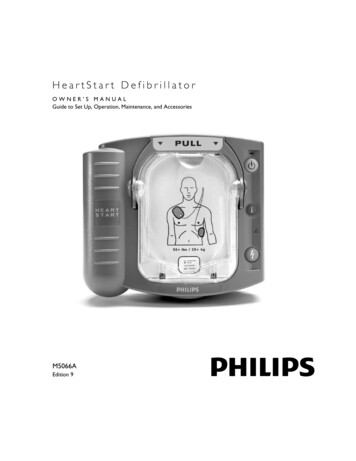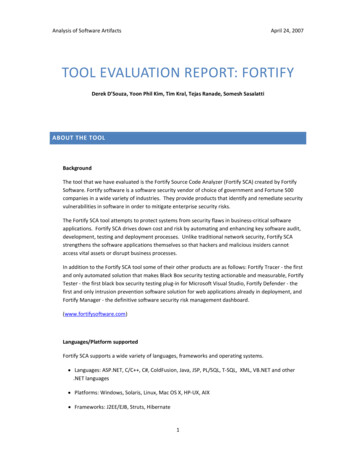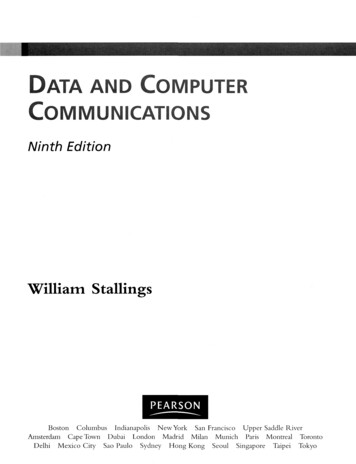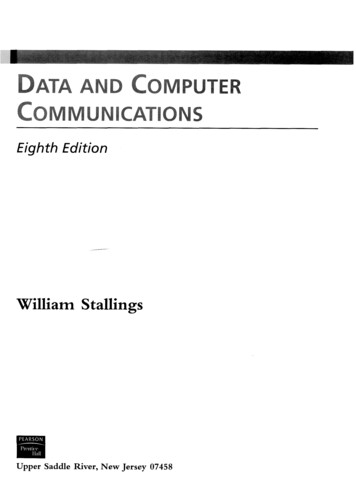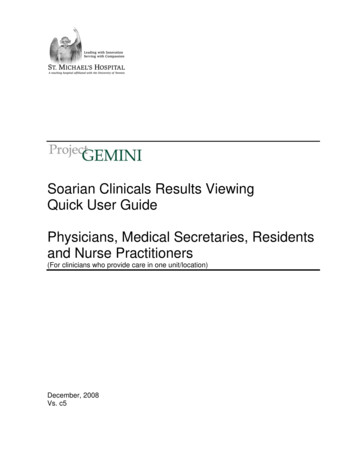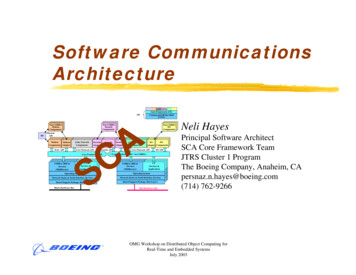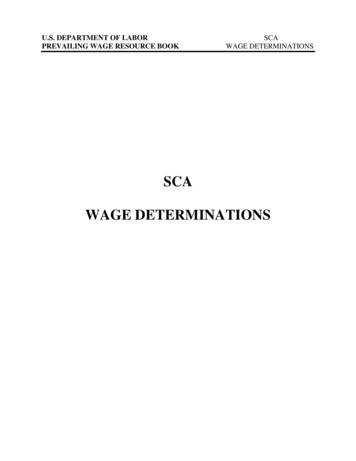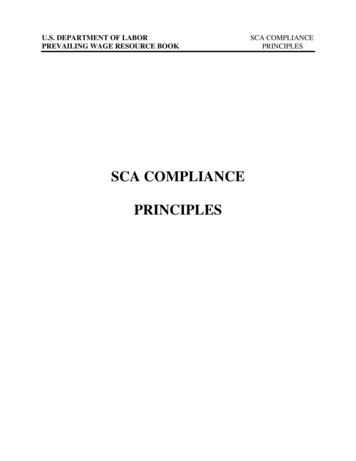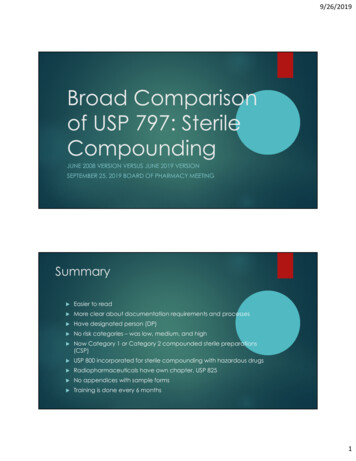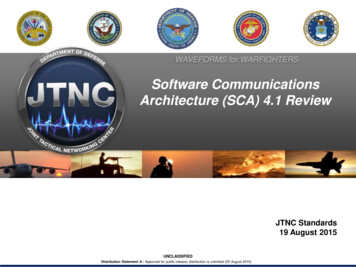
Transcription
WAVEFORMS for WARFIGHTERSSoftware CommunicationsArchitecture (SCA) 4.1 ReviewJTNC Standards19 August 2015UNCLASSIFIEDDistribution Statement A - Approved for public release; distribution is unlimited (25 August 2015)
UNCLASSIFIEDSCA 4.1 BLUFIn development for 2 years First SCA 4.1 workshop was 21-22 Nov 13 atRaytheon, San Diego Technologies and features of the new version Cyber re-proofing Commercial industry provided much of thetechnology and design of SCA 4.1 SCA 4.1 will be submitted to the DoD ITStandards Registry (DISR) in FY16Benefits to the Warfighter Cyber HardeningSmaller RadiosLonger Battery LifeFaster BootupBetter Connections with ExternalDevices such as AndroidFuture-proofingDistribution Statement A - Approved for public release; distribution is unlimited (25 August 2015)2
UNCLASSIFIEDSCA Continues to Distinguish Itselffrom Competing Standards SCA provides a framework similar toiOS and Android but allows flexibility SCA is different from iOS or Androidthrough the expression of waveformsin software (Software Defined Radio) The SCA is managed and controlledthrough an open systems standardsbody The SCA isolates the waveform fromthe radio set, enabling portability ofwaveforms across radio missions andmanufacturersDistribution Statement A - Approved for public release; distribution is unlimited (25 August 2015)3
UNCLASSIFIEDSCA Radios – In WidespreadDeployment Handhelds such as AN/PRC154, AN/PRC-152, AN/PRC148 have been fielded inquantities of over 300,000 Airborne, manpack, and multichannel radios include MIDSJTRS, HMS Manpack, AN/PRC117G, FlexNet, Phoenix, Freedom350, KOR-24, CRIIS, Talon,Sidehat, Sidewinder, and manymore Distribution Statement A - Approved for public release; distribution is unlimited (25 August 2015)4
UNCLASSIFIEDArchitecture Changes in SCA 4.1Architecture SCA 4.1 introduces a single basecomponent that is applicable forboth platform and applicationsoftware Earlier versions of the SCAhad mixed components andinterfaces, complicating thespecification A smaller number ofcomponents are reusedacross the full radio domain The reorganization will streamline implementations and allow better software toolingto be developed for SCA developersDistribution Statement A - Approved for public release; distribution is unlimited (25 August 2015)5
UNCLASSIFIEDCyber Hardening in SCA 4.1 Secure computing practices have evolved sincethe first SCA version Push model registration provides more securecommunication between components As part of the architectural refactoring, theprincipal of least privilege was applied to allcommunication within the architectureSCA 2.2.2WaveformComponent2: Information only on RequestDomainManager1: Request for DataSCA 4.11: Always Sends ager Access and visibility of all software componentshas been reduced to only what is absolutelyneeded This minimizes system exposure to a ‘rogue’software component within the radio applicationFactories: ApplicationFactorySequenceapplications: ApplicationSequencedeviceManagers: DeviceManagerSequencedomainManagerProfile: stringfileMgr: FileManageridentifier: string installApplication(string) : voidregisterDevice(Device, DeviceManager) : voidregisterDeviceManager(DeviceManager) : voidregisterService(Object, DeviceManager, string) : voidregisterWithEventChannel(Object, string, string) : voiduninstallApplication(string) : voidunregisterDevice(Device) : voidunregisterDeviceManager(DeviceManager) : voidunregisterFromEventChannel(string, string) : voidunregisterService(Object, string) : voidDistribution Statement A - Approved for public release; distribution is unlimited (25 August 2015)6
UNCLASSIFIEDReducing the Cost of the Radio –Scalability and Flexibility SCA 4.1 reduces software development and testing by tailoringfunctionality and interfaces not required for the radio’s mission Earlier versions of the SCA had a one-size fits-all model In SCA 2.2.2, a component had to implement all of the interfaceswhether they were specifically needed for the component or notclass Resource«interface»LifeCycle «interface»ComponentIdentifier identifier: stringinitialize() : voidreleaseObject() : void«interface»ControllableComponent started: boolean start() : voidstop() : void«interface»PropertySet perties) : voidquery(Properties*) : voidCONTROLLABLECONFIGURABLE connectUsesPorts(Connections) : voiddisconnectPorts(Disconnections) : voidgetProvidedPorts(Connections*) : void«interface»TestableObj ect runTest(unsigned long, Properties*) : bution Statement A - Approved for public release; distribution is unlimited (25 August 2015)7
UNCLASSIFIEDImproving Performance The SCA has little impact on waveformdata throughput The software components of thewaveform communicate amongthemselves without any SCA overhead orinterference During startup, there can be substantialdynamic configuration and loading ofsoftware components The new port communication and pushregistration significantly reduce the timeto boot the radio or launch a newwaveform This extends battery life, reduces theprocessor size and resources necessary toperform the missionDistribution Statement A - Approved for public release; distribution is unlimited (25 August 2015)8
UNCLASSIFIEDFuture-Proofing SCA 4.1 has been written as a modularspecification, permitting new technologyto be inserted into tactical radios As an example, there are emergingtechnologies to replace CORBA such asICE or zeroMQ SCA 4.1 is written to allow newtransports to be substituted for CORBA,which most SCA developers to date havepreferred New to SCA 4.1 is multicore processorsupportDistribution Statement A - Approved for public release; distribution is unlimited (25 August 2015)9
Dec 17, 2019 · in software (Software Defined Radio) The SCA is managed and controlled through an open systems standards body The SCA isolates the waveform from the radio set, enabling portability of waveforms a
